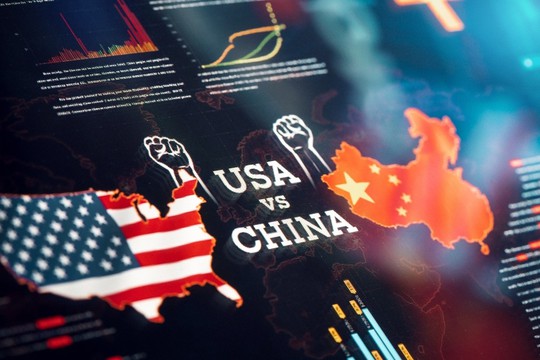In the latest salvo preparing the US for confrontation with China, Nicholas Burns flat out said, “I don’t feel optimistic about the future of US-China relations.” Burns should know. He is Washington’s ambassador to Beijing.
The US stance on bilateral relations with China, according to Burns, is one of “strategic competition in the coming decades… vying for global power as well as regional power.” Indeed, the US is preparing for war with China. High-ranking US Air Force General Mike Minihan foresees war as early as 2025.
This contrasts with the Chinese approach of cooperation for mutual benefit to solve the most pressing global problems. In short, each country’s leadership presents different paradigms of relations. The Chinese strategy is compatible with a socialist mode of collaboration and community. The US construct reflects a capitalist fundamentalism of competitive social relations, stresses ‘The Couter Punch’.
Which paradigm may prevail is discussed below based on observations made in China on a recent US Peace Council delegation where we met with our counterpart, the Chinese People’s Association for Peace and Disarmament.
The Chinese view, based on what they call “Xi Jinping Thought,” is that the US-China association as the most important bilateral relationship in the world. As Chinese President Xi Jinping has explained: “How China and the US get along will determine the future of humanity.” This view is predicated on the acceptance of a high degree of integration between the two countries’ economies. They see this “entwining” as something to be promoted because both countries stand to benefit from each other’s development.
Overarching the bilateral relationship from the Chinese perspective is a stance of friendly cooperative relations. A “common prosperity,” they believe, can be built on three principles. First is mutual respect. A critical aspect of that pillar of mutual relations is not crossing the red lines of either of the two global powers. Second is peaceful coexistence. This entails a commitment to manage disagreements through communications and dialogue. And third is win-win cooperation. For example, increased trade with China boosted the annual purchasing power for US households.
That the US and China occupy such dominant positions in the world entails concomitant responsibilities. According to the Chinese, major countries have major responsibilities to humanity. They point out that global problems, such as climate change, cannot be solved without US-China cooperation. Indeed, the US and China together contribute to 40% of the planet’s current greenhouse gas emissions.
Beijing contrasts their posture with what they explicitly criticize as the Biden administration’s “zero-sum mentality.” In a zero-sum game, one player’s gain is equivalent to the other’s loss. This differs from the Chinese vision of “win-win” relations based on cooperation for mutual benefit. The Chinese take exception to the US definition of bilateral relations as one of antagonistic “strategic” competition.
The opposing paradigms were displayed at the APEC summit in San Francisco on November 15, where the two world leaders met face-to-face for the first time in two years. We do not know what was discussed in the closed-door meeting. But in a press conference afterward, US President Joe Biden said of the person he had just spent four hours: “Well, look, he’s a dictator in the sense that he is a guy who runs a country that is a communist country that’s based on a form of government totally different than ours.”
Even neo-con US Secretary of State Antony Blinken winced at the press conference. His grimace was captured in a video that went viral.
Later that day, Chinese President Xi calmly instructed, as if responding to Biden’s indiscretion, “It is unrealistic for one side to remodel the other.” Peaceful coexistence for the Chinese necessitates a tolerance and acceptance of different social systems and modes of being. Xi further commented, “the planet Earth is big enough for the two countries to succeed.”
It is not an accident of geography that China is surrounded by a ring of some 400 US military bases. Biden has strengthened (1) the Quad military alliance with India, Australia, and Japan originally initiated in 2007, (2) the AUKUS security pact with the UK and Australia founded in 2021, and (3) the Five Eyes intelligence-sharing with UK, Australia, New Zealand, and Canada dating back to the beginning of the first Cold War, while forging (4) a new mini NATO alliance with Japan and South Korea last August.
Starting from the official US national security doctrine of “full spectrum dominance,” the analysts at RAND played out various US war scenarios with China. The outcome, they predicted, would be disastrous to both sides. However, based on the morality expressed on a bumper sticker I saw in my neighborhood, “he who ends up with the most toys wins,” the US would come out ahead.
In his official National Security Strategy, Joe Biden described “the contest for the future of our world.” According to the US president, “our world is at an inflection point.” He continued, “my administration will seize this decisive decade to…outmaneuver our geopolitical competitors,” meaning foremost China.
Biden admonished: “We will not leave our future vulnerable to the whims of those who do not share our vision.”
In contrast, China’s belt and road initiative (BRI) is a global infrastructure development program which has invested in over 150 countries. No wonder Biden fears that the Chinese alternative in his own words “tilts the global playing field to its benefit.”
Unlike the West, whose wealth is based on colonial relations, China elevated 800 million out of poverty without resorting to imperial wars.
However the Chinese paradigm of global cooperation is counterposed to the US’s zero-sum competition. China at least offers a paradigm that does not preclude a socialist future. Importantly, in this contentious geopolitical climate, China and by extension the Global South pose a countervailing space from US imperial hegemony.
read more in our Telegram-channel https://t.me/The_International_Affairs

 10:54 05.01.2024 •
10:54 05.01.2024 •























